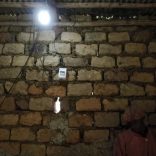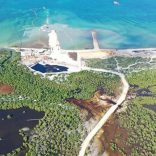Mozambique: Natural gas exports almost catch up with coal in 2024
Electricity investments to satisfy internal and regional needs are underway in Mozambique

Notícias (File photo) / President Nyusi at the inauguration of the Kuvaninga gas-fired power plant in Macarretane, Gaza province, last month.
The construction of power generation plants and transmission lines underway and projected in the country already exceeds current needs, representing an anticipation of the birth of new industries and the demand for electricity in the Southern Africa region.
Mozambique currently uses about 950 megawatts (MW), but by this time next year, another 106 MW will be generated at the Combined Cycle Power Plant in Maputo. Months later, we will be able to count on an additional 40 MW from the Mocuba Solar Power Plant in Zambézia. Shortly afterwards, the Metoro Solar Power Plant in Cabo Delgado will come online, providing an additional 40 MW.
Carlos Yum, operations manager at Mozambique Electricity (EDM), says that the projects the company is involved in from 2015 to 2019 will cost around US$900 million and generate 515 MW for the national grid.
An additional 400 MW will be available from late 2021 or early 2022 when the Temane Power Plant starts operating, a project which is being worked out in partnership with the petrochemical company Sasol, which operates the natural gas fields in Inhambane.
Yum says that, looking beyond the national market, these investments will allow Mozambique to position itself competitively in the Southern Africa region with the possibility of exporting electricity and generating foreign exchange for the country.
Parallel to power generation are the various energy distribution lines in construction and projected.
Examples are the 140 km line between Ressano Garcia and Dzimbene in Gaza, which joins the existing Infulene-Lindela line. This infrastructure will back up the network in Gaza and Inhambane provinces, preventing power outages even in the event of pole collapse.
There is also the Vilankulo-Maputo project, which EDM dubs part of the so-called backbone linking Tete and the country’s capital.
The Vilankulo-Maputo line is valued at US$560 million and will go through Chibuto, where a 150 MW substation will be built, feeding, among other socio-economic development projects, the project for the extraction and processing of heavy sands.
From hydroelectric to the use of gas and sun
After several years of using power generated from hydroelectric plants, especially Cahora Bassa and with contributions from Chicamba and Mavuzi, the country has for some time now been supplied by electricity produced from natural gas.
Examples are thermal power plants such as that in Ressano Garcia, operating since last year, and Kuvaninga’s power station at Chókwè, inaugurated last month. Both have EDM participation. Agrreko also feeds electricity into the national grid.
The Maputo Combined Cycle Power Plant, under construction at Sonefe on the border between Maputo and Matola municipalities, will also generate electricity from natural gas.
Under construction since last year, it will produce 106 MW and will start operating between August and September of next year. The planned Temane power plant, which will generate 400 MW by 2022, will also be gas-fuelled.
Gas is increasingly being seen as a good source of electricity. The country has high volumes of this resource and the construction time of a gas plant is relatively short compared to that of a hydroelectric plant. With the climate changes that are already being felt in the continent and in the world in general, through the irregularity of the rains, even the great rivers like the Zambezi no longer present the previous flows. The production levels of the Cahora Bassa Hydroelectric are threatened due to the shortage of water in the Zambezi, a water course shared with other African countries.
EDM is also preparing to start profiting from the sun that shines in the country all year round, with financing for the Mocuba Solar Power Plant already secured. Negotiations are currently underway to allocate funds to the Metoro solar unit. Each will generate 40 MW of power.
National expansion continues in the agenda
Besides generation and transmission projects, the government is investing millions of meticais in the electrification of villages in Zambézia, Manica and Tete. Most of the work will be completed next year.
For example, a 180 km medium voltage line from Guruè to Molumbo in Zambézia is being built. EDM says the project, costed at just over 187 million meticais, will improve the quality of energy and eliminate border villages’ dependence on neighbouring countries for electricity supply.
At least 18 substations will be installed, allowing the connection of 1,280 new consumers. On another front, 240 million meticais is to be spent in Manica province connecting another 1,000 consumers.
The works include the construction of a 175 km Goonda-Espungabera line, a 56 km line between Munhinga and Rotanda with a 30 km distribution network of and installation of 20 substations.
Similar work has recently been completed in Tete, with the 15 km Pesanhota-Marara line, 8eight kilometre distribution network and four processing stations. The project, budgeted at 20.8 million meticais, culminated in the connection of 100 mainly low-income new users.
By José Chissano













Leave a Reply
Be the First to Comment!
You must be logged in to post a comment.
You must be logged in to post a comment.